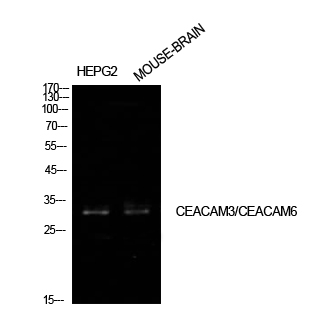产品名称
CD66c/d Rabbit Polyclonal Antibody
别名
CEACAM3; CD66D; CGM1; Carcinoembryonic antigen-related cell adhesion molecule 3; Carcinoembryonic antigen CGM1; CD66d; CEACAM6; NCA; Carcinoembryonic antigen-related cell adhesion molecule 6; Non-specific crossreacting antigen; Normal cross-reacting antigen; CD66c
蛋白名称
Carcinoembryonic antigen-related cell adhesion molecule 3/Carcinoembryonic antigen-related cell adhesion molecule 6
存储缓冲液
Liquid in PBS containing 50% glycerol, 0.5% BSA and 0.02% New type preservative N.
Human Gene Link
http://www.ncbi.nlm.nih.gov/sites/entrez?db=gene&term=1084/4680
Human Swissprot No.
P40198/P40199
Human Swissprot Link
http://www.uniprot.org/uniprotkb/P40198/P40199/entry
Rat Gene Link
http://www.ncbi.nlm.nih.gov/sites/entrez?db=gene&term=
Rat Swissprot Link
http://www.uniprot.org/uniprot/
免疫原
The antiserum was produced against synthesized peptide derived from the Internal region of human CEACAM3/CEACAM6. AA range:31-80
特异性
CD66c/d Polyclonal Antibody detects endogenous levels of CD66c/d protein.
稀释度
WB 1:500 - 1:2000. ELISA: 1:10000. Not yet tested in other applications.
宿主
Polyclonal, Rabbit,IgG
背景介绍
This gene encodes a member of the family of carcinoembryonic antigen-related cell adhesion molecules (CEACAMs), which are used by several bacterial pathogens to bind and invade host cells. The encoded transmembrane protein directs phagocytosis of several bacterial species that is dependent on the small GTPase Rac. It is thought to serve an important role in controlling human-specific pathogens by the innate immune system. Alternatively spliced transcript variants have been described. [provided by RefSeq, Mar 2013],
组织表达
CGM1a, the predominant CGM1 transcript, is granulocyte-specific. Not detected out of the granulocytic lineage, such as monocytes, lymphocytes, spleen, testis, colon, brain, liver, pancreas, thymus, ovary, placenta, skeletal muscle, prostate, small intestine, heart, lung and kidney.
细胞定位
Membrane; Single-pass type I membrane protein.
功能
caution:This is not the ortholog of rat CEACAM3.,domain:The cytosolic domain is involved in S100A9 interaction.,function:Major granulocyte receptor mediating recognition and efficient opsonin-independent phagocytosis of CEACAM-binding microorganisms, including Neissiria, Moxarella and Haemophilus species, thus playing an important role in the clearance of pathogens by the innate immune system. Responsible for RAC1 stimulation in the course of pathogen phagocytosis.,PTM:Tyrosine-phosphorylated in response to microbial binding. Tyr-230 and Tyr-241 are both required for phosphorylation to be detected.,similarity:Belongs to the immunoglobulin superfamily. CEA family.,similarity:Contains 1 Ig-like V-type (immunoglobulin-like) domain.,subunit:Interacts with S100A9/calprotectin. This interaction is calcium-dependent, but independent of CEACAM3 phosphorylation.,tissue specificity:CGM1a, the predominant CGM1 transcript, is granulocyte-specific. Not detected out of the granulocytic lineage, such as monocytes, lymphocytes, spleen, testis, colon, brain, liver, pancreas, thymus, ovary, placenta, skeletal muscle, prostate, small intestine, heart, lung and kidney.,
纯化
The antibody was affinity-purified from rabbit antiserum by affinity-chromatography using epitope-specific immunogen.

.jpg)
